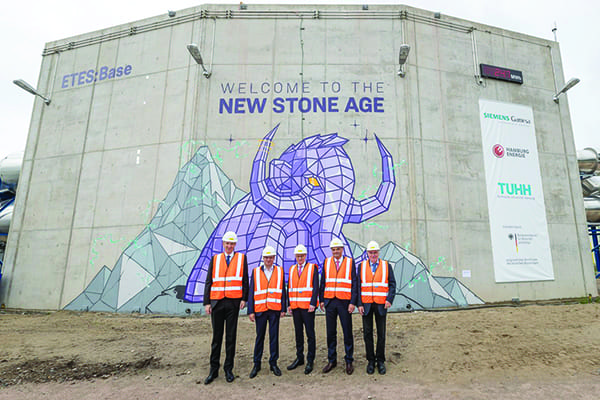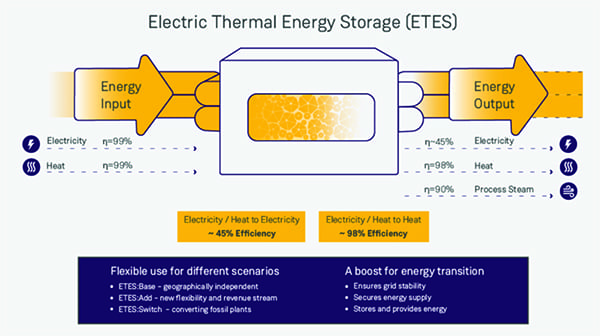Volcanic Rock Offers New Take on Energy Storage
Credit to Author: POWER| Date: Thu, 01 Aug 2019 00:00:00 +0000
Siemens Gamesa Renewable Energy (SGRE), known for its wind turbines used in both large onshore and offshore projects, in June began operation of an electric thermal energy storage (ETES) system in Germany (Figure 1). The technology is designed to store large quantities of energy, using volcanic rock as the storage medium.
 |
1. From left to right, Michael Prinz, Managing Director, Hamburg Energie GmbH; Andreas Feicht, State Secretary, Ministry of Economic Affairs and Energy; Peter Tschentscher, First Major of Free and Hanseatic City of Hamburg; Markus Tacke, CEO, Siemens Gamesa Renewable Energy (SGRE); and Prof. Dr.-Ing. Gerhard Schmitz, Technical University Hamburg (TUHH) in front of the electric thermal energy storage (ETES) system. Courtesy: SGRE |
“The technology employs an electric heater to charge the storage and a conventional heat recovery steam cycle to discharge the storage,” Veronica Diaz Lopez, who handles external communications for Siemens Gamesa, told POWER. “For charging, electricity is converted into hot air and blown through the storage, which is filled with volcanic rocks.”
 |
2. This chart shows how the technology for ETES works. Courtesy: SGRE |
The project includes about 1,000 metric tons of volcanic rock. The electrical energy is converted into hot air by means of a resistance heater and a blower that heats the rock to 750C/1,382F (Figure 2). “In the storage the heat is transferred from the air to the rocks and stored,” said Lopez. “During discharging, the flow direction through the storage is reversed and cold air enters the storage from the opposite end. In the storage, the air is heated up by the rocks and leaves the storage as hot air. The hot air is guided through a boiler where the energy is used to produce steam. The steam runs a steam turbine, which in combination with an electric generator, produces electricity.”
The system is installed at the Trimet SE aluminum smelter site in Hamburg-Altenwerder. The ETES pilot plant can store up to 130 MWh of thermal energy for a week, and its storage capacity remains constant throughout the charging cycles, according to SGRE. The company said the plant has a generator rated at 1.4 MW that produces energy for up to 24 hours. SGRE wants to use the storage technology in commercial projects, with plans to increase the storage capacity and power output as the technology is developed. SGRE said its goal is to store energy in the range of several GWh in the future. “Currently we are planning to do the commercial rollout in the mid 2020s,” said Lopez.
“Decoupling generation and consumption of fluctuating renewable energy via storage is an essential contribution to implementing the energy system transformation,” said Andreas Feicht, state secretary at Germany’s Federal Ministry of Economics and Energy, which funded the project known as Future Energy Solutions (FES). “We therefore need cost-effective, efficient, and scalable energy storage systems.”
Markus Tacke, SGRE’s CEO, in a news release said, “With the commissioning of our ETES pilot plant, we have reached an important milestone on the way to introducing high-performance energy storage systems. Our technology makes it possible to store electricity for many thousands of households at low cost. We are thus presenting an elementary building block for the further expansion of renewable energy and the success of the energy transition.”
The Institute for Engineering Thermodynamics at Hamburg University of Technology (TUHH) and Hamburg Energie, the local utility, are partners in the project. “After a construction period of more than one year the demonstrator inauguration was an important milestone in the Future Energy Solutions research project,” said Lopez.
The research project includes research and development (R&D) activities, planning, engineering, construction, and operation of the demonstrator for a period of five years. The overall project volume of the FES project is €28.5 million (about $32.4 million), split among all three partners for all activities, Lopez said.
The university group is researching the thermodynamic fundamentals of the solid bulk technology. Hamburg Energie is responsible for marketing the stored energy on the electricity market. A flexible digital control system is being developed, with a goal of having the ETES optimize its storage of renewable energy and provide maximum output when needed. SGRE said the ETES technology costs “significantly” less than other energy storage solutions, and even at a GWh-scale “would be highly competitive compared to other available storage technologies.”
SGRE said the technology is recommended for “large scale and flexible energy storage for renewable energy plants, combined heat and power, and [as a] second-life option for conventional power plants.” SGRE began developing models of the technology in 2012, and began operating a 5-MWh test site in 2014.
The ETES that came online in June is considered a “proof of system” plant. SGRE is touting the cost-effectiveness of the project, noting that “for the conversion process of electricity into a hot air stream, it uses fans and heating elements out of mass production. The same applies to the re-conversion: Via a highly dynamic Siemens steam boiler, a standard steam turbine is operated to generate electricity at the end of the process chain.” SGRE said much of its R&D for the ETES focused on the insulated container to house the volcanic rock, what it calls “virtual battery and core innovation.”
SGRE said TUHH has supported the project by “modeling the processes inside the storage unit, which results in principles for thermodynamic calculations of the processes.” SGRE said, “One of the key findings was an optimized shape of the container with the rock fill. The design of the storage container of the new project reflects this: Its round bodied shape will have a decreasing diameter at both ends, where the inflow and the outflow openings are positioned. The ferroconcrete giant will have a content of 800 cubic meters of rock-fill with a mass of 1,000 tons and will be covered with a meter-thick layer of thermal insulation.”
“The beauty of the ETES technology is that it is not just a storage technology but a flexibility solution, because it can use electricity as well as heat for charging and can provide electricity, heat, and process steam while discharging,” said Lopez. “Further, it can be used to convert fossil-fueled conventional power plants into emission-free GWh storage facilities.”
—Darrell Proctor is a POWER associate editor.
The post Volcanic Rock Offers New Take on Energy Storage appeared first on POWER Magazine.